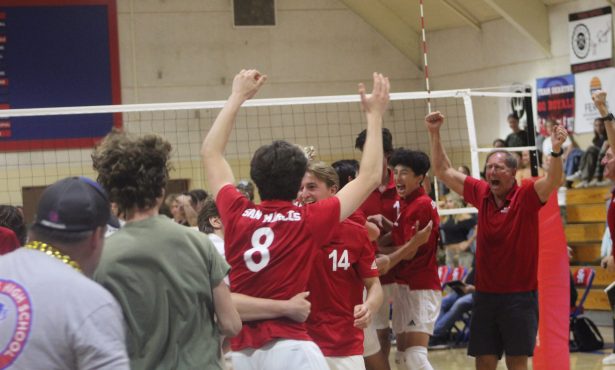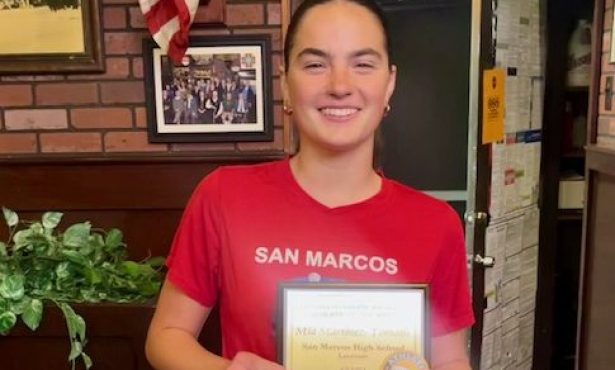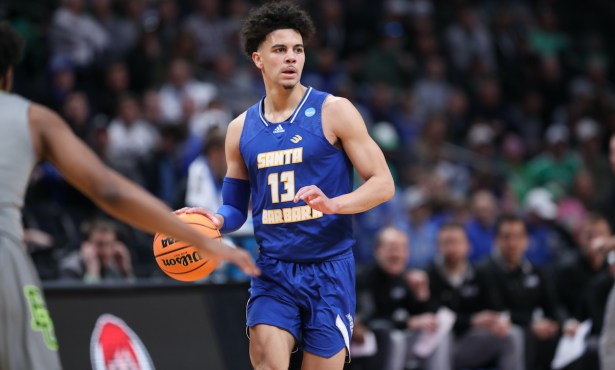Arc of a Rainbow
Basketball Clinics for Japanese Youth in Wake of Fukushima

the art of shooting. Also on hand, to translate, was Colson’s friend Hirosumi Tomatsu.
Gary Colson attained a reputation as a fixer when he patched up a University of New Mexico basketball program that had been riddled by scandal in 1980. He also managed to win his share of games as coach of the Lobos, as he had previously at Pepperdine. Colson retired in 1995 with 563 wins in a head-coaching career that spanned 34 seasons at four colleges.
He took a position in athletic administration at UCSB, and every chance he got, he would show up in the gym and impart some knowledge to the Gaucho coaches and players. During the 2000-’01 season, Colson got to know Hirosumi Tomatsu, a visiting coach from Japan’s Osaka Basketball Association. Tomatsu had come to UCSB to take an advanced course in college basketball. He observed every Gaucho practice and was on the bench at the games.
Colson heeded another call to be a fixer last August. He gave some clinics to young Japanese basketball players in Iwaki, a coastal city in the Fukushima Prefecture, an area hard-hit by the earthquake and tsunami in March 2011. Assisting him as a translator was his old friend Tomatsu.
“Coach Gary Colson’s specialty for the kids was the art of shooting,” Tomatsu reported. “Coach Colson had them all ‘holding their poise’ after the release of the ball. Coach Colson also taught them, ‘Flight of shooting ball must have a rainbow look.’ His using such expression ‘rainbow’ must have given those Fukushima people big hope and bravery for the recovery from the quake disaster.”
Even though more than a year had passed since the devastation, Colson said, “Everybody was still scared.” He was impressed by how thoroughly they had cleaned up the area. “I did not see one sign of graffiti,” he said. “I give my hat off to the people in Japan. They were so nice, polite, and gracious.”
Colson returned to Japan last month to give clinics in Osaka and Kyoto. That brought to almost 1,000 the number of Japanese youngsters who have received instruction from him. As before, his wife, UCSB physical therapist Mary Katherine Colson, accompanied Colson and gave advice on the treatment of injuries.
With few exceptions, the Japanese players are small. Colson, who counts Hall of Fame guard Jerry West as one of his best friends, pointed out that they share that characteristic with some noteworthy NBA players. “Steve Nash is small. Chris Paul is small.”
The theme of the clinics was “simplicity and execution,” and Tomatsu affirmed that the lessons were “easy to understand for kids.” Colson said, “I couldn’t have done it without Coach Tomatsu. He is such a nice, intelligent person. I had to rely on his translation. I think my message got across, but a couple times I told a joke, and nobody laughed.”
Colson viewed his efforts as “planting a seed,” and he hopes to be around when the youngsters he taught mature into college-age players. One of his jokes refers to his own maturity: “I like to say that when James Naismith put up the first basket, I held the ladder.”
BEN NOT BROKEN: The UCLA Bruins have many fans in Santa Barbara because of Ben Howland, the local boy who made good as John Wooden’s most successful successor. It did not sit well with Howland’s homies when athletic director Dan Guerrero decided to fire him as Bruins basketball coach. Guerrero hired Steve Alford, whose record in the NCAA tournament at New Mexico could not compare to Howland’s three Final Four appearances in 10 years at UCLA. Both the Bruins and Alford’s Lobos were lackluster in their first-round exits from this year’s tournament.
Howland faced challenges that the revered Wooden did not have to deal with — a conference tournament that diminishes the accomplishment of winning the regular-season title; an expanded NCAA tournament; pressure to recruit players who may leave school after one season, even if they do not live up to their reputations — all related to financial considerations. Howland reaped the rewards of the system, earning more than 50 times Wooden’s annual salary of $35,000. UCLA reportedly has to pay him $3.5 million to buy out his contract.
Howland, a former gym rat at the Goleta Boys & Girls Club, invested in a house on the Mesa where he may settle down some day (not all that soon, as he is too good a coach not to land another job). He recently told Mark Patton of the News-Press: “I was shocked to see that Deano’s Pizza and Foster’s Freeze on the Mesa are now both gone. I was really looking forward to going there. They have a bank going in there now.” A bank is exactly what Howland needs.



